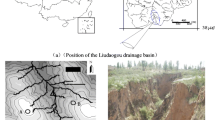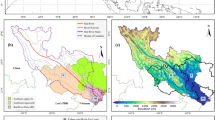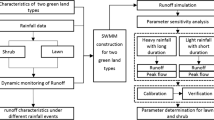Abstract
Runoff generation is an important part of water retention service, and also plays an important role on soil and water retention. Under the background of the ecosystem degradation, which was caused by the vulnerable karst ecosystem combined with human activity, it is necessary to understand the spatial pattern and impact factors of runoff generation in the karst region. The typical karst peak-cluster depression basin was selected as the study area. And the calibrated and verified Soil and Water Assessment Tool (SWAT) was the main techniques to simulate the runoff generation in the typical karst basin. Further, the spatial variability of total/surface/groundwater runoff was analyzed along with the methods of gradient analysis and local regression. Results indicated that the law of spatial difference was obvious, and the total runoff coefficients were 70.0%. The groundwater runoff was rich, about 2–3 times the surface runoff. Terrain is a significant factor contributing to macroscopic control effect on the runoff service, where the total and groundwater runoff increased significantly with the rising elevation and slope. The distribution characteristics of vegetation have great effects on surface runoff. There were spatial differences between the forest land in the upstream and orchard land in the downstream, in turn the surface runoff presented a turning point due to the influence of vegetation. Moreover, the results of spatial overlay analysis showed that the highest value of total and groundwater runoff was distributed in the forest land. It is not only owing to the stronger soil water retention capacity of forest ecosystem, and geologic feature of rapid infiltration in this region, but also reflected the combining effects on the land cover types and topographical features. Overall, this study will promote the development and innovation of ecosystem services fields in the karst region, and further provide a theoretical foundation for ecosystem restoration and reconstruction.
Similar content being viewed by others
References
Amatya D M, Jha M, Edwards A E et al., 2011. SWAT-based streamflow and embayment modeling of karst-affected chapel branch watershed, South Carolina. Transactions of the ASABE, 54(4): 1311–1323.
Bai Xiaoyong, Wang Shijie, 2011. Relationships between soil loss tolerance and karst rocky desertification. Journal of Natural Resources, 26(8): 1315–1322. (in Chinese)
Beven K J, Kirkby M J, Schofield N et al., 1984. Testing a physically-based flood forecasting model (TOPMODEL) for three U.K. catchments. Journal of Hydrology, 69(1): 119–143.
Borba B S M C, Szklo A, Schaeffer R, 2012. Plug-in hybrid electric vehicles as a way to maximize the integration of variable renewable energy in power systems: The case of wind generation in northeastern Brazil. Energy, 37(1): 469–481.
Brunsdon C, Fotheringham A S, Charlton M, 1996. Geographically weighted regression: A method for exploring spatial nonstationarity. Geographical Analysis, 28(4): 281–298.
Brunsdon C, Fotheringham A S, Charlton M, 1998. Geographically weighted regression: Modelling spatial non-stationarity. Journal of the Royal Statistical Society Series D: The Statistician, 47(3): 431–443.
Chen Hongsong, Nie Yunpeng, Wang Kelin, 2013. Spatio-temporal heterogeneity of water and plant adaptation mechanisms in regions: A review. Acta Ecologica Sinica, 33(2): 317–326. (in Chinese)
Chen Xi, Zhang Zhicai, Rong Li et al., 2014. Process of Water Cycle and Effect of Eco-hydrology in the Karst Region of Southwestern China. Beijing: Science Press. (in Chinese)
Costanza R, D’Arge R, Groot R D et al., 1997. The value of the world’s ecosystem services and natural capital. Nature, 387(15): 253–260.
Dai Quanhou, Peng Xudong, Yang Zhi et al., 2017. Runoff and erosion processes on bare slopes in the karst rocky desertification area. Catena, 152: 218–226.
Daily G C, 1997. Nature’s Services: Societal Dependence on Natural Ecosystems. Washington, DC: Island Press.
Fischer G F, Nachtergaele S, Prieler H T et al., 2008. Global agro-ecological zones assessment for agriculture (GAEZ 2008). IIASA, Laxenburg, Austria and FAO, Rome, Italy.
Fu Bojie, Wang S, Su C H et al., 2013. Linking ecosystem processes and ecosystem services. Current Opinion in Environmental Sustainability, 5(1): 4–10.
Fu Bojie, Yu Dandan, 2016. Trade-off analyses and synthetic integrated method of multiple ecosystem services. Resources Science, 38(1): 1–9. (in Chinese)
Fu Bojie, Zhang Liwei, 2014. Land-use change and ecosystem services: Concepts, methods and progress. Progress in Geography, 33(4): 441–446. (in Chinese)
Gao Jiangbo, Cai Yunlong, 2010. Spatial heterogeneity of landscape fragmentation at multi-scales: A case study in Wujiang river basin, Guizhou Province, China. Scientia Geographica Sinica, 30(5): 742–747. (in Chinese)
Hu Yi, Dai Quanhou, Wang Peijiang, 2012. Runoff features and the influencing factors on karst sloping farmland. Journal of Soil and Water Conservation, 26(6): 46–51. (in Chinese)
Jaeger J A G, 2000. Landscape division, splitting index, and effective mesh size: New measures of landscape fragmentation. Landscape Ecology, 15(2): 115–130.
Li Shuangcheng, 2014. The Geography of Ecosystem Services. Beijing: Science Press. (in Chinese)
Li Zhou, Gao Kaimin, Liu Jinchun et al., 2016. Growth response of two annual herb species to alternating drying-wetting and nitrogen addition in the karst area of Southwest China. Acta Ecologica Sinica, 36(11): 3372–3380. (in Chinese)
Lin Bingqing, Chen Xingwei, Chen Ying et al., 2014. Simulations and analysis on the effects of landscape pattern change on flood and low flow based on SWAT model. Acta Ecologica Sinica, 34(7): 1772–1780. (in Chinese)
Liu Changming, Du Wei, 1985. An application of system analysis to water allocation in the first-stage project of the east-route water transfer in China. Geographical Research, 4(3): 81–88. (in Chinese)
Liu Jiyuan, Kuang Wenhui, Zhang Zengxiang et al., 2014. Spatiotemporal characteristics, patterns and causes of land use changes in China since the late 1980s. Acta Geographica Sinica, 69(1): 3–14. (in Chinese)
Lv Leting, Peng Qiuzhi, Guo Yuanyuan et al., 2014. Runoff simulation of Dongjiang river basin based on the soil and water assessment tool. Journal of Natural Resources, 29(10): 1746–1757. (in Chinese)
Mcgarigal K, Marks B J, 1995. FRAGSTATS: Spatial analysis program for quantifying landscape structure. Dolores Po Box, 351.
Mcmichael C E, Hope A S, Loaiciga H A, 2006. Distributed hydrological modeling in California semi-arid shrublands: MIKESHE model calibration and uncertainty estimation. Journal of Hydrology, 317(3): 307–324.
Millennium Ecosystem Assessment (MEA), 2005. Ecosystems and Human Well-Being. Washington DC: Island Press.
Pan Shibing, Lu Jingxuan, 2010. Karst groundwater exploitation in Southwest and countermeasure to cope with drought. China Water Resources, 13: 40–42. (in Chinese)
Peng T, Wang S J, 2012. Effects of land use, land cover and rainfall regimes on the surface runoff and soil loss on karst slopes in southwest China. Catena, 90(1): 53–62.
Popov E G, 1979. Gidrologicheskie Progonozy (Hydrological Forecasts). Leningrad: Gidrometeoizdat.
Shi Peili, Li Wenhua, 2001. Influence of forest cover change on hydrological process and watershed runoff. Journal of Natural Resources, 16(5): 481–487. (in Chinese)
Southwestern China. Beijing: Science Press, 2014. (in Chinese)
Tian Y, Wang S, Bai X et al., 2016. Trade-offs among ecosystem services in a typical karst watershed, SW China. Science of the Total Environment, s566/567: 1297–1308.
Wang S J, Liu Q M, Zhang D F, 2004. Karst rocky desertification in southwestern China: Geomorphology, land use, impact and rehabilitation. Land Degradation & Development, 15(2): 115–121.
Wang X Z, Liang Z X, Wang J, 2014. Simulation of runoff in karst-influenced Lianjiang Watershed using the SWAT model. Scientific Journal of Earth Science, 4(2): 85–92.
Wu Xiyuan, Zhang Liping, 2006. Research on effecting factors of precipitation’s redistribution of rainfall intensity, gradient and cover ratio. Journal of Soil and Water Conservation, 20(4): 28–30. (in Chinese)
Xu H, Xu C Y, Sælthun N R et al., 2015. Entropy theory based multi-criteria resampling of rain gauge networks for hydrological modelling: A case study of humid area in southern China. Journal of Hydrology, 525(A): 138–151.
Yuan Daoxian, 2015. Scientific innovation in karst resources and environment research field of China. Carsologica Sinica, 34(2): 98–100. (in Chinese)
Zhang Mingyang, Wang Kelin, Liu Huiyu et al., 2011. The response of ecosystem service values to ambient environment and its spatial scales in typical karst areas of northwest Guangxi, China. Acta Ecologica Sinica, 31(14): 3947–3955. (in Chinese)
Zhang Z, Chen X, Huang Y et al., 2013. Effect of catchment properties on runoff coefficient in a karst area of southwest China. Hydrological Processes, 28(11): 3691–3702.
Zhou F, Xu Y, Chen Y et al., 2013. Hydrological response to urbanization at different spatio-temporal scales simulated by coupling of CLUE-S and the SWAT model in the Yangtze River Delta region. Journal of Hydrology, 485: 113–125.
Acknowledgements
All the authors thank the Data Center for Resources and Environmental Sciences, Chinese Academy of Sciences (RESDC) and EOS/Terra of National Aeronautics and Space Administration, for producing and sharing the land use and NDVI dataset, respectively.
Author information
Authors and Affiliations
Corresponding author
Additional information
Foundation: National Basic Research Program of China, No.2015CB452702; National Natural Science Foundation of China, No.41671098, No.41530749; “Strategic Priority Research Program” of the Chinese Academy of Sciences, No.XDA20020202; Open Foundation of Laboratory for Earth Surface Processes (LESP) Ministry of Education
Rights and permissions
About this article
Cite this article
Hou, W., Gao, J. Simulating runoff generation and its spatial correlation with environmental factors in Sancha River Basin: The southern source of the Wujiang River. J. Geogr. Sci. 29, 432–448 (2019). https://doi.org/10.1007/s11442-019-1608-z
Received:
Accepted:
Published:
Issue Date:
DOI: https://doi.org/10.1007/s11442-019-1608-z




